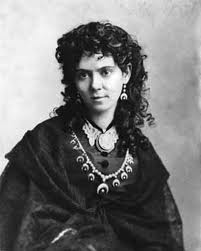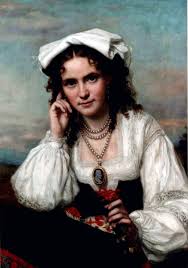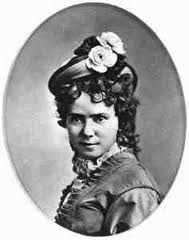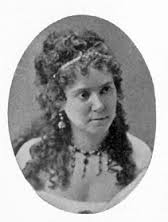 Lincoln’s Beautiful Sculptor, Vinnie Reams, was not only the youngest and the first woman to receive a commission from the United States Government for a statue, but from her studio in the basement of the U.S. Capitol Building, her brilliance and artistic talents lent credence to her persona as an Enchanting Washington Nymph. When Vinnie addressed the International Council of Women in 1909, she summed up her artistic pursuits, stating,
Lincoln’s Beautiful Sculptor, Vinnie Reams, was not only the youngest and the first woman to receive a commission from the United States Government for a statue, but from her studio in the basement of the U.S. Capitol Building, her brilliance and artistic talents lent credence to her persona as an Enchanting Washington Nymph. When Vinnie addressed the International Council of Women in 1909, she summed up her artistic pursuits, stating,
“I have worked in my studio not envying kings in their splendor; my mind to me was my kingdom and my work more than diamonds and rubies.”
She was a tiny woman, just five feet tall and never weighing more than 90 pounds, but her vision and her pluck, cut a broad swath among the politicians and power brokers during and after the Civil War in Washington D.C.
 Lavinia Ellen Ream was born on September 25, 1847, in Madison, Wisconsin. She was the youngest daughter of Robert and Lavinia Ream. Robert Ream was a surveyor and a Wisconsin Territory official. The Reams also operated a stage-coach stop, one of the first hotels in Madison, from their home.
Lavinia Ellen Ream was born on September 25, 1847, in Madison, Wisconsin. She was the youngest daughter of Robert and Lavinia Ream. Robert Ream was a surveyor and a Wisconsin Territory official. The Reams also operated a stage-coach stop, one of the first hotels in Madison, from their home.
When she was seven years old, the Ream family moved to Washington, D.C. There Ream had her first chance to model with clay in the studio of sculptor Benjamin Paul Akers, who said she showed talent. After a few years in Washington, the Ream family moved to Kansas so that Robert Ream could take a surveying job.
In 1854, when the family moved to Kansas, Vinnie was sent to school in St. Joseph, Missouri. Three years later she attended Christian College in Columbia, Missouri, where her musical and artistic abilities caught the attention of James Rollins, a local lawyer, politician, and supporter of the school. Ream’s encounter with Rollins proved fruitful in the years to follow.
In 1861, at the beginning of the Civil War, the Ream family packed up again and moved back to Washington, D.C. Only a teenager, Ream became one of the first women to work for the United States Postal Service, where she worked as a clerk starting in 1862. To help with the war effort, Ream volunteered to write letters for wounded soldiers in the hospitals. She also sang in hospital concerts and for local churches. She had boundless energy. At one time she told her mother,
“I feel that I am to have some special work in the world. I don’t know what it is, but I must be ready for it when it comes.”
 While in Washington, Ream reestablished contact with James S. Rollins, who was now a U.S. Congressman. Rollins remembered Vinnie’s desire to become a sculptor, and he took her to visit Clark Mills, one of the country’s most prominent sculptors. Mills offered Ream the opportunity to work in his studio. Her artistic talents blossomed under Mills’s instruction. Ream accepted commissions to create portrait busts of prominent individuals and was soon earning enough money to quit her job at the post office.
While in Washington, Ream reestablished contact with James S. Rollins, who was now a U.S. Congressman. Rollins remembered Vinnie’s desire to become a sculptor, and he took her to visit Clark Mills, one of the country’s most prominent sculptors. Mills offered Ream the opportunity to work in his studio. Her artistic talents blossomed under Mills’s instruction. Ream accepted commissions to create portrait busts of prominent individuals and was soon earning enough money to quit her job at the post office.
In 1864, the precocious young artist requested to sculpt a bust of President Abraham Lincoln, and the successful outcome of this project encouraged Vinnie to pursue a prestigious commission to sculpt a full-length statue of the President. Her attainment of the $10,000 commission in 1866 was not easily won, however, as the 19-year-old was met with resistance by those who criticized her skill, age, gender, charm, and physical beauty.
A contract was signed August 30, 1866: $5,000 to be paid on acceptance of the full-size plaster model, and $5,000 on completion of the marble. Vinnie Ream was the first of her sex to execute sculpture for the United States government; she had impressive endorsement, both political and military. Armed with Secretary Seward’s letter of recommendation to the American diplomatic and consular representatives in Europe, the young sculptor, accompanied by her parents, went to Rome to put the statue of Lincoln into marble.
In January 1871 Ream’s statue of Lincoln, done in white Carrara marble, was unveiled at the Capitol. Although later criticized for its lack of vigour and its manifest amateurishness, it possessed a naive expressiveness and was warmly received at the time. In January 1875, in competition with such prominent artists as Story and Ward, Ream won a $20,000 commission from the government to create a bronze statue of Admiral Farragut. Her sculpture, cast from the propeller of the naval hero’s flagship, was unveiled in April 1881 in Farragut Square, Washington D.C.
In 1878, at age 30, Vinnie married Lieutenant Richard Leveridge Hoxie. It was a remarkable wedding. President Ulysses S. Grant, General William T. Sherman, and most of the Senate of the United States attended the wedding. Although Vinnie would create more than 100 works during her life, there was a long period of inactivity following her marriage. Her husband asked her not to follow her career and Vinnie followed his wishes.
For some years they traveled around the country as Hoxie built and rebuilt fortifications in many parts of the United States. He had a long career as Chief of Army Engineers and retired as a Brigadier General.
 Although she continued to model and sculpt, she did not obtain another public commission until 1906, when she began work on a statue of James Kirkwood, Iowa’s Civil War governor. In 1912 she received the commission for a statue of the great Cherokee chief Sequoyah for Statuary Hall in the U.S. Capitol, but Vinnie died before completion and a fellow artist finished the project.
Although she continued to model and sculpt, she did not obtain another public commission until 1906, when she began work on a statue of James Kirkwood, Iowa’s Civil War governor. In 1912 she received the commission for a statue of the great Cherokee chief Sequoyah for Statuary Hall in the U.S. Capitol, but Vinnie died before completion and a fellow artist finished the project.
In addition to those already mentioned, portrait-busts or medallions include famous names: General Grant, General McClellan, General Frémont; Senator Sherman, Peter Cooper, Ezra Cornell, Horace Greeley, Liszt, Kaulbach, Spurgeon. Among her ideal figures are “The West,” “The Indian Girl,” “The Spirit of the Carnival,” “Miriam,” “Sappho.”
Vinnie Ream died of uremic poisoning on November 20, 1914, in Washington, D.C. and she and her husband rest together at Arlington National Cemetery in Virginia, under a bronze copy of her “Sappho.”
Vinnie Ream, was so much more than just Lincoln’s Beautiful Sculptor, she represented the beginning of an era, when women not only began to change the world and the male mindset, but an example to young women the world over, on how female tenacity and talent can and does make a dynamic difference.
Bummer

